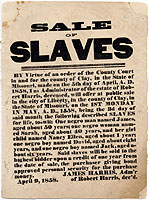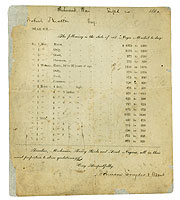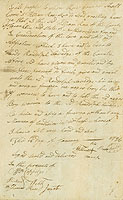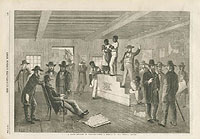
![]()
Slave Sale Broadside from Missouri, 1858.
![]()
![]()
Slave Dealer’s Price Listing. Richmond, Virginia: Johnson, Snyder
and Adams, September 20, 1860.
![]()
![]()
Deed of Gift for a Slave. Franklin County, North Carolina, 1796.
![]()
![]()
“A Slave Auction in Virginia.” Illustrated London News. February
16, 1861.
![]()
The Business of Selling
Slaves
![]()
As in any mercantile system, slave agents recorded, insured, advertised,
displayed, and finally, sold their “wares” to the highest
bidders. To prepare for sales, dealers fed, cleaned, and oiled down slaves
to hide disease and to improve appearance. Sales took place on ship decks,
in slave pens, by preset contract, or at auction. On the auction block,
potential buyers examined every part of these men and women's anatomy.
Healthy young men usually sold first and for the highest value.
Printed advertisements for the sale of slaves were posted to attract buyers and often provided descriptions of available “merchandise.”
Gift of Gail ’56 and Stephen Rudin.
This manuscript document transferred ownership of a slave from William Rose to Randolph Savedge. The deed gives to “Randolph Savedge, his heirs and assigns, one Negro boy by the name of Warren.”
Gift of Gail ’56 and Stephen Rudin.
This wood engraving depicts an indoor slave auction. A slave mother and child stand on a raised platform as the auctioneer conducts the bidding. Other slaves stand in the background awaiting their fate on the auction block.
Gift of Gail ’56 and Stephen Rudin.
![]()
- The Middle Passage
- The Business of Selling Slaves
- Life in Bondage
| |
| |
| |
| |
| |
| |
| |
| |
| |
| |
| |
| |

Copyright © 2002 Division
of Rare & Manuscript Collections
2B Carl A. Kroch Library, Cornell University, Ithaca, NY, 14853
Phone Number: (607) 255-3530. Fax Number: (607) 255-9524
For reference questions, send mail to:
rareref@cornell.edu
For questions or comments about the site, send mail to: webmaster.


